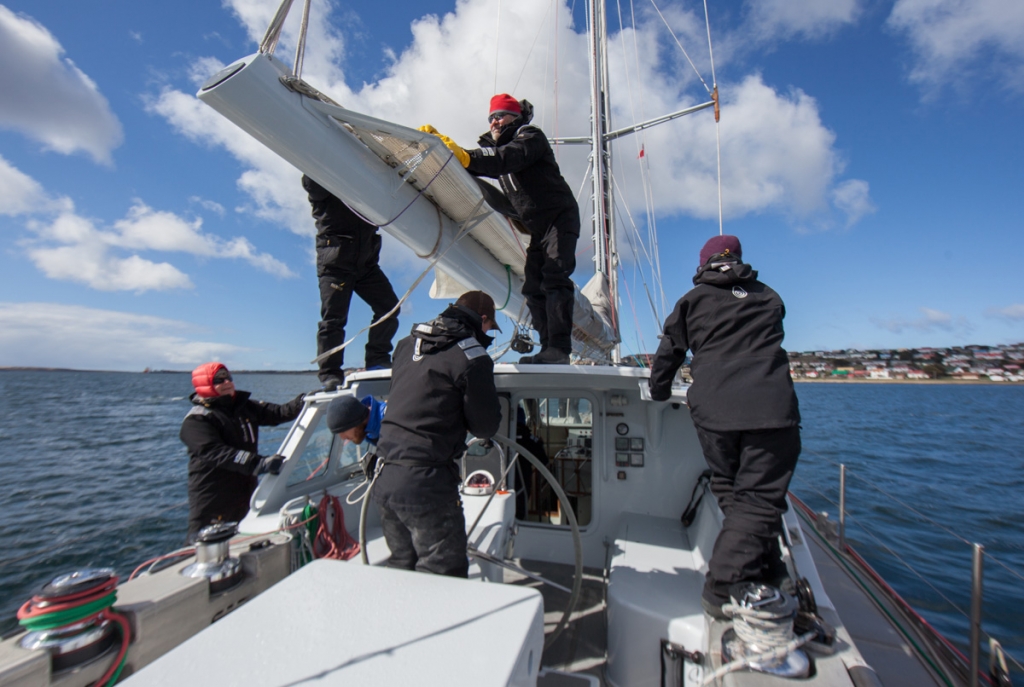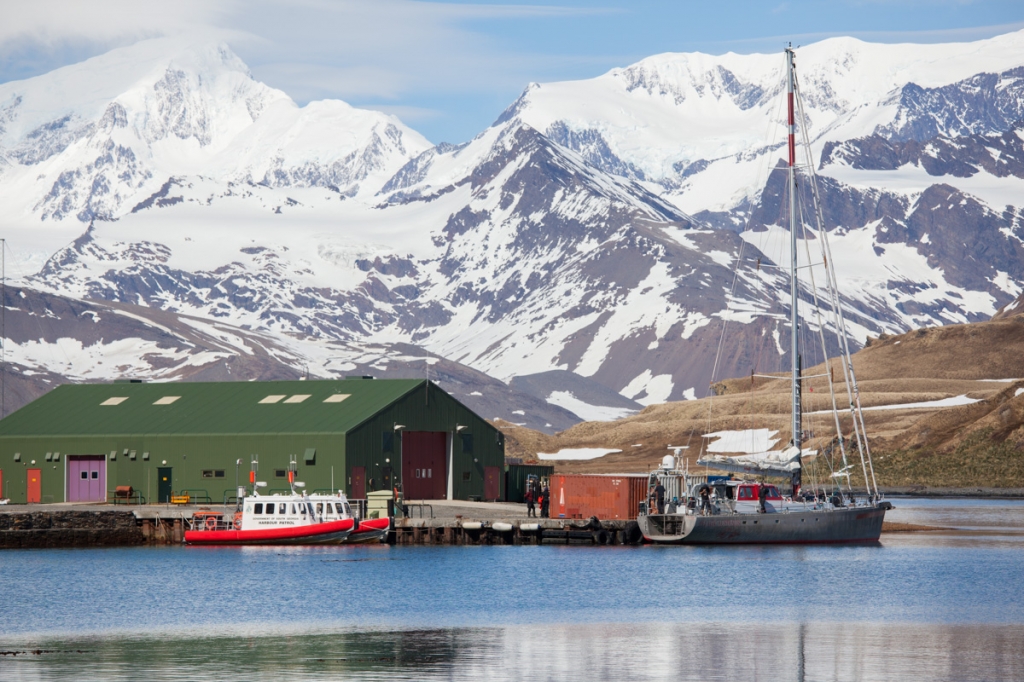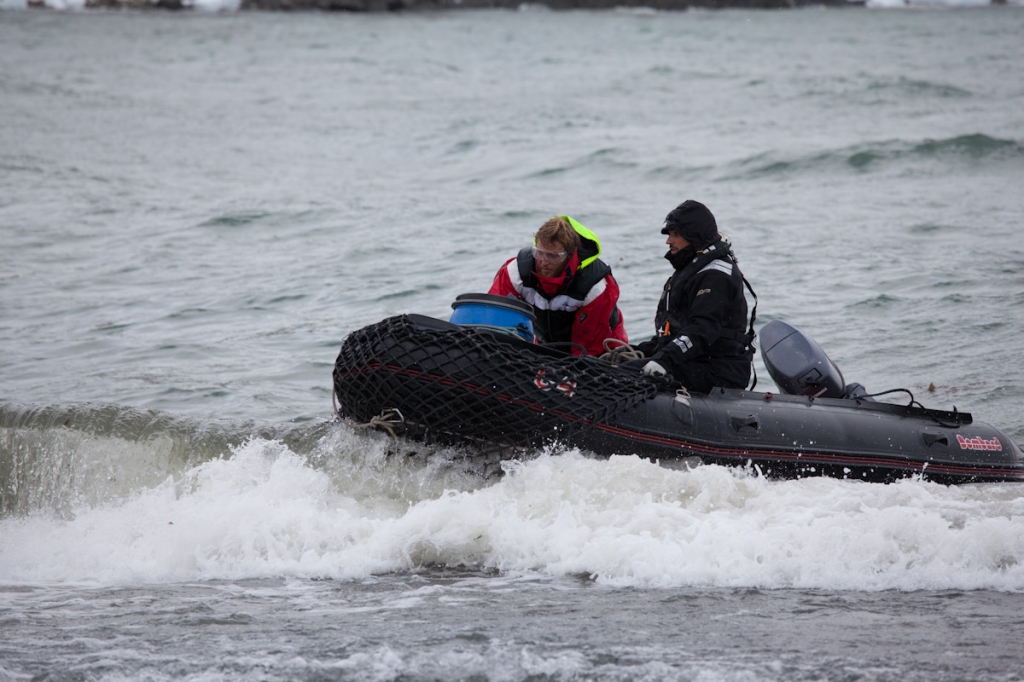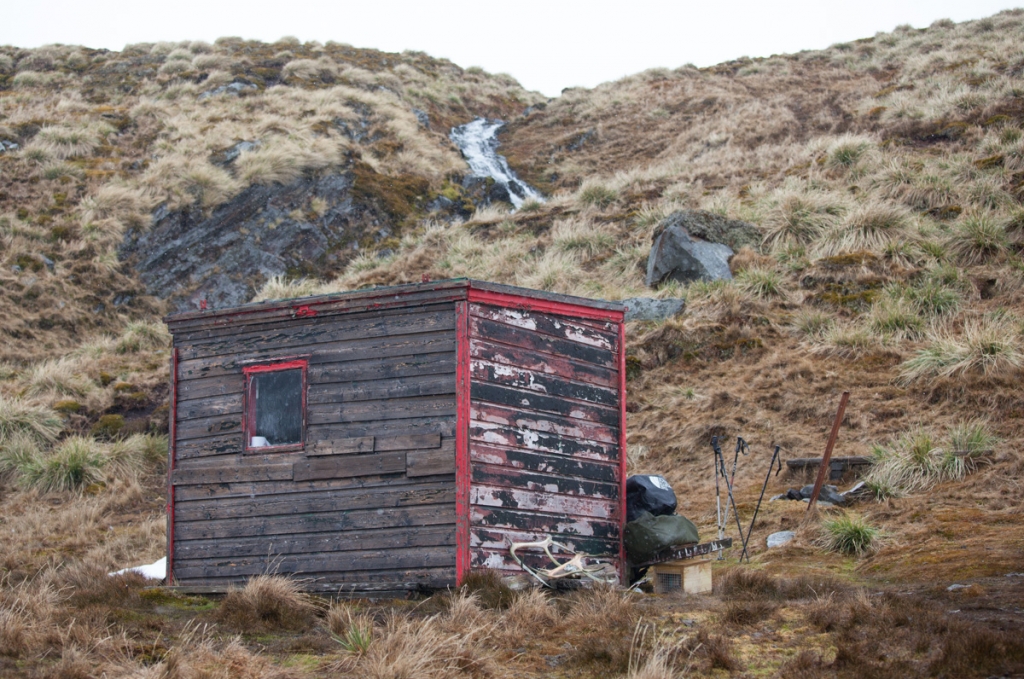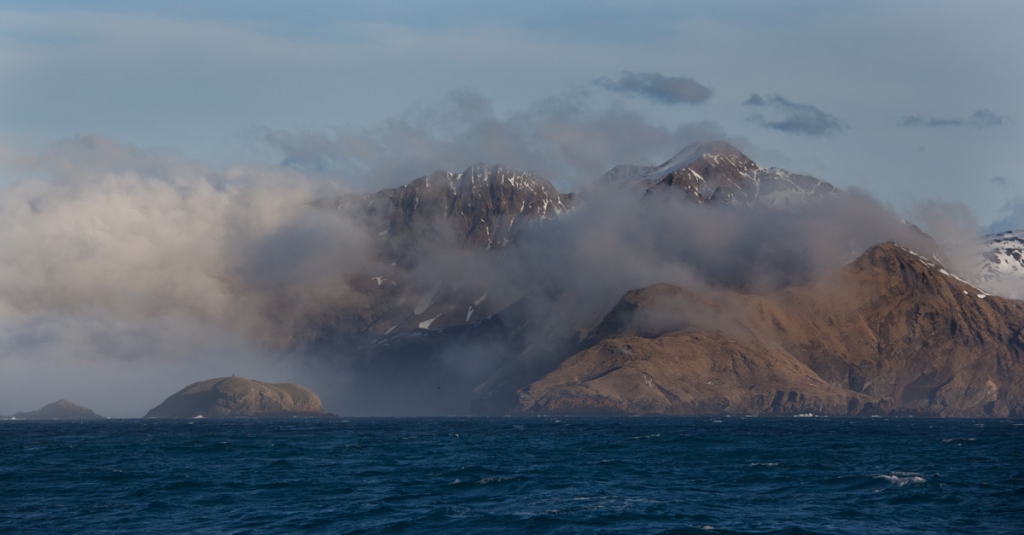
Kuli South Georgia Expediton
Researchers with UMaine’s Climate Change Institute will be blogging while on a trip to South Georgia Island in the South Atlantic Ocean. The expedition members are Climate Change Institute Director Paul Mayewski, UMaine graduate students Bjorn Grigholm and Mariusz Potocki, UMaine postdoctoral researcher Dan Dixon, Chilean researchers Gino Casassa and Marcelo Arevalo, EMT medic Alex Kuli, and freelance journalist Alex George Kuli. The Kuli South Georgia Expedition team is expecting to return Nov. 4, depending on weather.
Kuli South Georgia Expedition
10th October 2012 – Fourth Day On Open Ocean
53 degrees, 27.08’ South / 42 degrees, 36.36’ West
Our expedition started out on the morning of October 2nd at the Concord Bus Station in Bangor, Maine. Five of us (Alex, Paul, Dan, Mario, Bjorn) arrived by 6:30am with 17 bags, each weighing ~50lb. The bus crews gave us a puzzled look but were helpful loading the bags nonetheless. Roughly four hours later we arrived at Logan airport and proceeded to check in our mountain of bags.
Our first flight was relatively short, to New York JFK where we boarded a much larger plane ready for our 11-hour flight to Santiago, Chile. It is always somewhat nerve-wracking traveling with so much gear… One always wonders if it will all make it. Upon arrival at Santiago on the 3rd, we passed through immigration and then on to customs… to our surprise all the bags made it through and we promptly re-checked them in again for our next flight – to Punta Arenas. While in Santiago we met up with an old Chilean friend from previous expeditions, Gonzalo Campos. Gonzalo had some business to attend to in Punta Arenas and had timed his flight so that we could travel together. It is always good seeing Gonzalo in Chile. We stepped off the plane in Punta Arenas around noon and were pleasantly surprised to see all our bags once again! Gonzalo spoke to one of the airport staff in Punta Arenas and arranged for us to store all of our gear in a small building close to the airport, thus saving us the trouble of moving our mountain of bags across town in a fleet of cabs. Later that night, Alex Junior flew in from Budapest, Hungary. Paul and Alex Senior (Alex Junior’s Dad) took a cab out to the airport to greet him. To resolve the confusion of having two Alexes in tow, we decided to call Alex Junior by his middle name, George.
We spent October 4th and 5th in Punta Arenas catching up with work, meetings, and last minute preparations for the expedition. Gino and Marcelo flew in and met up with us by the evening of the 5th. On the 6th we once again headed to Punta Arenas airport, this time to catch our flight to the Falkland Islands. The crunch this time was that the Falkland Islands flight only flies once per week… So if one of our bags should not make it, it could spell the end of the expedition – each bag is critical. With the addition of Gino and Marcelo we now had over 20 bags! To give all of our bags a fighting chance of making the flight we arrived at the airport by 9am… Hopefully plenty of time to get the bags loaded for a 1pm take off.
Upon arrival at Mount Pleasant military base we were very happy, and relieved, to see that our bags had all made it once again. We piled our bags and ourselves into two vans that were waiting for us and began the long drive along mostly gravel roads to the only permanent large settlement on the Falkland Islands, the town of Stanley. Along the way we saw several farms, a few with cows, but mostly with sheep. The landscape is very flat and dry, almost no trees and lots of scrub – a very windy place to live. We also caught sight of several minefield warnings, a stark reminder of the 1982 Falklands war.
We were greeted in Stanley by the crew of the Pelagic Australis, Magnus Day (the Skipper), Kali Kahn (first mate), and Edd Hewett (second mate). Light was beginning to fade so we immediately began to load our gear onto the boat. The Pelagic Australis is to be our transport to the island of South Georgia. She is a fine vessel, a 74-foot ocean-going one-off, built in 2003 from sheet aluminum.
We set sail on the 7th and have spent the last few days ‘getting our sea-legs’ as we experience every type of weather imaginable (excluding calm sunny conditions of course!). The Pelagic crew is second-to-none and they handle the boat with a calm experience that instills trust. We have had a lot of fun helping to crew the boat and learning some of the ins-and-outs of open ocean voyaging.
12th October 2012 – Land Ho!
54 degrees, 16.897’ South / 36 degrees, 30.467’ West
The island of South Georgia is in sight. Two days ago, after four days of open ocean sailing, we got our first glimpse of South Georgia. It was a snow capped peak shrouded in clouds. We sailed another few hours along the coast before we reached Right Whale Bay. The calm waters of the bay were a welcome relief for us as it meant ship activities (e.g. eating) were not concurrent with large rocking motions. Looking onto the shore we could see clusters of elephant and fur seals, penguin colonies, and various other sea birds (blue petrel, southern giant petrel, snowy sheathbill, Antarctic tern, snow petrel, black-browsed albatross, and cape petrel). The anchor was put down a few hundred meters from shore. The plan, weather dependent, was to stay the night sheltered in the bay and head out early the next morning to our final destination: Possession Bay (~30 miles to the east). At dinner, Paul and Magnus downloaded and reviewed weather reports. The reports predicted rough weather with increasingly heavy winds (up to 60 knots) over the next few days. It was decided that the Possession Bay landing would be postponed until the weather lightened. Instead, we would travel to King Edward Point (KEP) with a short stop in Possession Bay to scout potential landing sites. The stop in Possession Bay gave us views of two possible access routes to the drill site on Esmark glacier. Both routes are roughly 11 miles and entail climbing the glacier that sits on the slopes of the southwest side of the bay. The glacier leads up to a region named Murray Snowfield which then needs to be crossed to reach Esmark glacier (our drill site at 900 meters elevation). After an hour or so in the bay we were off again and headed to KEP.
King Edward Point is the location of a British Antarctic Survey (BAS) research station and the local Government Authority of South Georgia and the South Sandwich Islands (SGSSI). Upon arrival, visitors must show permits and be inspected by bio-security. The island is particularly susceptible to invasive species; rats are a prime example of a non-native species that is harmful to the South Georgia ecosystem. Rats have decimated bird populations at certain locations on the island. Animal species are not the only environmental threat, foreign vegetation is also a serious concern. During the early 20th century, along with rats, whalers brought with them reindeer and dandelion, both of which are still found on the island.
We arrived at KEP in the early evening and tied the ship to the station dock. After our inspection, the setting sun gave us a little time to explore the area. A 20 minute walk brought us around the bay, through the abandoned whaling settlement of Grytviken, to Ernest Shackleton’s grave. The following morning Paul met with a British couple, Pat and Sarah Lurcock, who have spent the last 20 years working on the island. Pat has spent a great deal of time climbing in the area so Paul was very interested to hear his accounts on the glaciers here, especially his thoughts on our proposed route up to the drill site on Esmark Glacier.
Currently, we are waiting at KEP and are planning to return to Possession Bay tomorrow.
13th October 2012 – Change Of Plans
Reconnaissance Operations: Nordenskjold Glacier. Due to a poor weather forecast, the plan to sail to Possession Bay had to be postponed. Instead, we motored the Pelagic Australis over to the Nordenskjold Glacier on the other side of Cumberland Bay to assess the possibility of recovering some good quality basal ice. Unfortunately, the winds were too high to conduct zodiac operations safely and we had to return to KEP. A zodiac is a name for a heavy-duty inflatable motor boat. The zodiac aboard Pelagic Australis is ~12 feet long with a 25 horsepower outboard motor. What seems a small swell aboard the 74-foot Pelagic Australis, often proves to be unmanageable to a 12-foot zodiac loaded with gear and personnel. We spent the rest of the day preparing our gear for tomorrow’s mission, exploring the BAS station at KEP, and looking around the Grytviken museum.
14th October 2012 – The Barff Peninsula
At daybreak we left KEP and headed to the Barff Peninsula. Paul had identified a potential drill site with relatively easy access from the shore, the Szielasko Ice Cap. Once we reached the beach, the team split into two groups; one began searching for a base camp location and the other for a route to the ice cap. By the end of the day the weather had progressively grown worse and we had to decide whether to remain on the peninsula or return to the Pelagic Australis. In order to take advantage of any sudden improvements in the weather conditions, we decided that three KSG expedition members would stay at the emergency hut on Barff Peninsula and the rest of the team would return to the boat. The three (Bjorn, Mario, and Marcelo) that remained would continue to scout a route to the ice cap should conditions permit. The hut had two small bunks, two chairs, a paraffin lamp, a small shelf of books, and a barrel full of emergency supplies.
15th October 2012 – Weather Closing In
Driving wind, rain, and snow all day prevented all of us (notably the Barff Peninsula team) from working due to lack of visibility.
16th October 2012 – Success On Barff
Today the weather improved and the Barff team successfully scouted a route to the Szielasko Ice Cap and identified a potential drill site location. We discussed the change in plan with the SGSSI representative at KEP, Pat Lurcock, and received approval. The team aboard Pelagic Australis resupplied the Barff Peninsula base camp in the afternoon and left Gino to conduct radar surveys with the Barff team.
17th October 2012 – Snow Pit On Szielasko
Second attempt to collect basal ice from Nordenskjold Glacier by the KSG Pelagic Australis team… Unfortunately, conditions were too rough to launch the zodiac and we returned to KEP. Meanwhile, the Barff team successfully collected snow samples from a ~3m snow pit and conducted radar surveys on the Szielasko Ice Cap.
18th October 2012 – Nordenskjold Glacier
Early this morning we picked up Bjorn and Mario from the Barff Peninsula, leaving Gino and Marcelo behind to finish up radar surveys. The KSG Pelagic Australis team’s third attempt to collect basal ice was a Success! No wind all day – perfect weather for drilling. After several unsuccessful borings, we collected ~2.5m of good quality basal glacier ice from the debris-covered ice margin of the Nordenskjold Glacier. We collected Gino and Marcelo from Barff on the way back to KEP. Our team is whole once again.
19th October 2012 – Fortuna Glacier
Today we sailed to Fortuna Glacier and recovered a second core of basal ice from an ice-cored moraine. On the way back to KEP significant ocean swell was hitting Pelagic Australis on the port side causing the boat to heel significantly. A few of us felt a little green, perhaps a warning of things to come. In the evening, Paul gave a lecture to the BAS Staff at KEP. Afterwards, Magnus checked the weather forecast and the decision was made to head for Stanley before conditions worsened significantly (since it is a 6-10 day trip under reasonable conditions).
20th October 2012 – Exit Strategy
We decided, weather permitting, that we would attempt a short stop in Possession Bay to collect more data on our way back to Stanley. The majority of the morning was spent preparing for tomorrow’s mission. We hiked to Penguin River in the afternoon, a popular spot for local penguins to gather and molt. As we photographed the penguins, the wind picked up and it started snowing. We had a near-whiteout for about 20 minutes and then it was sunny again! The South Georgia weather changes frequently and drastically, often in mere minutes! This means that best laid plans can be thwarted with but a moment’s notice.
Unfortunately, our first mate, Kali, has hurt her back and cannot accompany us for the journey back to the Falkland Islands. Luckily for us, Will Whatley, a competent and experienced BAS First Mate is on hand at the station and willing to take Kali’s place for the journey back to the Falkland Islands. James Wake, BAS Base Commander at KEP, kindly came by with a fork lift to pick up our snow and ice samples for transport back to BAS in Cambridge, UK. They will arrive in May and we will go to Cambridge to bring them back for analysis at CCI.
21st October 2012 – Thwarted By Weather
Our first attempt to reach Possession Bay, at midnight last night, was unsuccessful. We had to turn around due to bad weather and heavy steep seas. We failed again in our second attempt at 9am this morning. We spent the rest of the afternoon hiking to the local Gentoo penguin colony ~11km from Grytviken.
22nd October 2012 – Escape from Grytviken Part III… Success!
Our plan to stop in Possession Bay had to be scrapped as we have run out of time and the weather seemed to be worsening. However, we motor-sailed to the Bay Of Isles and managed a very brief visit to the King Penguin colony on Salisbury Plain. Dan and Alex were the first to land on the beach, shortly afterwards the wind picked up significantly and zodiac operations had to be cut short. After Alex and Dan were returned to Pelagic Australis safely we headed out to sea and set our autopilot for the Falkland Islands.
23rd October 2012 – Second Day On Open Ocean
Weather seems to be moderating. We were beginning to think we could have squeezed in a few more days on South Georgia… However, a big storm looms in the weather prediction and we are well underway with too little time to turn around.
24th October 2012 – Third Day On Open Ocean
Wind ~15 knots from the north. Nice calm sailing at ~8 knots. Crossing the Antarctic convergence.
25th October 2012 – Fourth Day On Open Ocean
Some sun today!
26th October 2012 – Fifth Day On Open Ocean
Short seas and strong winds meant much heeling and hull banging throughout last night. The ongoing motion overwhelmed a few expedition members today… Seasickness for some! The storm took longer than expected to catch us, but it appears to be here with a vengeance.
27th October 2012 – Sixth Day On Open Ocean
Still pitching, rolling, and banging… Only 100 nautical miles away from Port Stanley! We had to heave-to for a while in order to fix our electrical generator and replace two broken alternator belts on the main engine.
28th October 2012 – On Dry Land
51 degrees, 41.509’ South / 57 degrees, 51.292’ West
After battling head-on against 45 knot winds for much of the night and 50 knot winds through mid-morning, we arrived in Port Stanley, Falkland Islands – much to the relief of our seasick expedition members. Had we not heeded Magnus’ advice, this most certainly would have been a much rougher crossing and perhaps closer to the 10 day estimate which might have conflicted with the next scheduled trip to South Georgia for Pelagic Australis.
We had to remain on board until a customs and immigration officer paid us a visit. Once we were cleared to go ashore, we headed straight to Shorty’s Diner for a full English breakfast… Yum! Since the once-weekly flight to Punta Arenas left yesterday, it seems we will be spending several days here. This gives us plenty of time to explore and get to know the place.
29th October 2012 – In Stanley
We all spent the day exploring around town, catching up on email, and eating naughty food from the local diners and pubs.
30th October 2012 – Hurricane At Home
Today was dedicated to unpacking and repacking our gear ready for the final leg of the expedition back to Maine. Hurricane Sandy plowed into the east coast of the United States last night and we are seeing many scenes of coastal destruction and flooding on the television here in Stanley.
31st October 2012 – Rain Rain Rain
It was a very soggy day for Halloween, but that did not deter the local children from trick-or-treating.
1st November 2012 – Falkland Islands Weather
Today we explored out of town. The weather alternated frequently between rain, sleet, hail, and snow. Later, one of the locals assured us that these are typical conditions for the Falkland Islands. You have to be of hardy stock to live here!
2nd November 2012 – Last Day In Stanley
Most of us spent the day exploring and taking photos. Paul gave a scientific presentation at Government House in the afternoon. He also did a radio and a TV interview describing our expedition and the value of future work.
3rd November 2012 – Journey Home
Today begins our long journey back to Maine. We fly from the Falkland Islands to Punta Arenas, to Santiago, to Miami, to Boston, and finally board a bus bound for Maine. We are due to arrive in Bangor, Maine at 9pm on Sunday. Let’s hope all the gear, fifteen fifty-pound bags, makes it back intact…It did!
Thank you to the Government of South Georgia and the South Sandwich Islands, the crew of Pelagic Australis, the British Antarctic Survey and the many friends we made along the way. There is much much more to be done to understand South Georgia’s past climate and through this to make better predictions for future climate in the South Atlantic.
This log was prepared by Dan Dixon, Bjorn Grigholm, Mario Potocki and Paul Mayewski.


